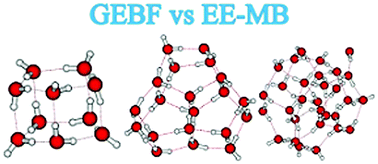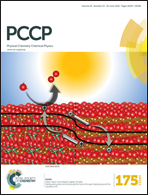Are fragment-based quantum chemistry methods applicable to medium-sized water clusters?†
Abstract
Fragment-based quantum chemistry methods are either based on the many-body expansion or the inclusion–exclusion principle. To compare the applicability of these two categories of methods, we have systematically evaluated the performance of the generalized energy based fragmentation (GEBF) method (J. Phys. Chem. A, 2007, 111, 2193) and the electrostatically embedded many-body (EE-MB) method (J. Chem. Theory Comput., 2007, 3, 46) for medium-sized water clusters (H2O)n (n = 10, 20, 30). Our calculations demonstrate that the GEBF method provides uniformly accurate ground-state energies for 10 low-energy isomers of three water clusters under study at a series of theory levels, while the EE-MB method (with one water molecule as a fragment and without using the cutoff distance) shows a poor convergence for (H2O)20 and (H2O)30 when the basis set contains diffuse functions. Our analysis shows that the neglect of the basis set superposition error for each subsystem has little effect on the accuracy of the GEBF method, but leads to much less accurate results for the EE-MB method. The accuracy of the EE-MB method can be dramatically improved by using an appropriate cutoff distance and using two water molecules as a fragment. For (H2O)30, the average deviation of the EE-MB method truncated up to the three-body level calculated using this strategy (relative to the conventional energies) is about 0.003 hartree at the M06-2X/6-311++G** level, while the deviation of the GEBF method with a similar computational cost is less than 0.001 hartree. The GEBF method is demonstrated to be applicable for electronic structure calculations of water clusters at any basis set.


 Please wait while we load your content...
Please wait while we load your content...